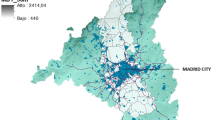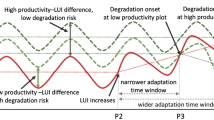Abstract
Many mountainous regions worldwide are characterized by harsh environments, scarce infrastructure, and extreme contrasts between mountains and neighboring plateaus and plains. Transhumance is a social adaptation to handle geomorphological heterogeneity such as lowlands and highlands, and to cope with environmental variability (seasonal and regional rainfall and snowfall). We studied the regional transhumant system with a network approach in the Andes of North Patagonia, Argentina. We measured the connectivity promoted by the seasonal movements of herds and people (relationships) among different ecosystems (nodes), defined as winter and summer lands. We identified 238 networks. The highest frequencies corresponded to small network structures (dyads and triads), suggesting that landscape management is highly decentralized. Network complexity was positively related to ecological richness and diversity of connected nodes. However, most networks were dependent upon a central node, suggesting vulnerable situations regarding disturbances affecting such key nodes. The identification of social–ecological traps of this mobile system provided novel insights for policy decision making, which otherwise would not be evidenced with traditional approaches. Management proposals and policy making should consider the spatial and temporal scales of transhumant pastoralism, in order to avoid problems derived from fixation logics, scale mismatches, and disconnection.





Similar content being viewed by others
References
Alfonso G, Prina A (2009) Catálogo florístico de la reserva Lagunas de Epu Laufquen, departamento Minas, provincia de Neuquén, Argentina. Ernstia 19(2):109–136
Anderies JM, Rodriguez AA, Janssen MA, Cifdaloz O (2007) Panaceas, uncertainty, and the robust control framework in sustainability science. Proc Natl Acad Sci 104(39):15194–15199. doi:10.1073/pnas.0702655104
Azpilicueta MM, Gallo LA, van Zonneveld M, Thomas E, Moreno C, Marchelli P (2013) Management of Nothfagus genetic resources: definition of genetic zones based on a combination of nuclear and chloroplast marker data. For Ecol Manag 302:414–424. doi:10.1016/j.foreco.2013.03.037
Batagelj V, Mrvar A (1998) Pajek—program for large network analysis. Connections 21(2):47–57
Bendini M, Steimbreger NG (2011) Persistencia campesina en el norte de la Patagonia: movilidades espaciales y cambios en la organización social del trabajo. Cuadernos de Desarrollo Rural 66:125–151
Bendini M, Nogués C, Pescio C (1993) Medio ambiente y sujetos sociales: el caso de los cabreros trashumantes. Debate Agrario 17:123–130
Bergmann C, Gerwin M, Sax WS, Nüsser M (2011) Politics of scale in a high mountain border region: being mobile among the Bhotiyas of the Kumaon Himalaya, India. Nomadic Peoples 15(2):104–129
Berkes F, Colding J, Folke C (2003) Navigating social-ecological systems: building resilience of complexity and change. Cambridge University Press, Cambridge
Bodin Ö, Norberg J (2007) A network approach for analyzing spatially structured populations in fragmented landscape. Landsc Ecol 22:31–44. doi:10.1007/s10980-006-9015-0
Bodin Ö, Crona B, Ernstson H (2006) Social networks in natural resource management: What is there to learn from a structural perspective? Ecol Soc 11(2):r2
Carlson JM, Doyle J (2002) Complexity and robustness. Proc Natl Acad Sci USA 99:2538–2545. doi:10.1073/pnas.012582499
Carpenter SR, Brock WA (2008) Adaptive capacity and traps. Ecol Soc 13(2):40
Cumming GS, Cumming DH, Redman CL (2006) Scale mismatches in social-ecological systems: causes, consequences, and solutions. Ecol Soc 11(1):14
Dyson-Hudson R, Dyson-Hudson N (1980) Nomadic pastoralism. Annu Rev Anthropol 9:15–61
Easdale MH (2015) A social-ecological vulnerability and robustness approach of livestock transhumant systems. Doctoral thesis. EPG Alberto Soriano, Facultad de Agronomía, Universidad de Buenos Aires
Easdale MH, Domptail SE (2014) Fate can be changed! arid rangelands in a globalizing world—a complementary co-evolutionary perspective on the current ‘desert syndrome’. J Arid Environ 100–101:52–62. doi:10.1016/j.jaridenv.2013.10.009
Easdale MH, Rosso H (2010) Dealing with drought: social implications of different social smallholder survival strategies in semi-arid rangelands of Northern Patagonia, Argentina. Rangel J 32(2):247–255. doi:10.1071/RJ09071
Fernández-Giménez ME (1999) Sustaining the steppes: a geographical history of pastoral land use in Mongolia. Geogr Rev 89:315–342. doi:10.1111/j.1931-0846.1999.tb00222.x
Fernández-Giménez ME (2000) The role of Mongolian nomadic pastoralists’ ecological knowledge in rangeland management. Ecol Appl 10:1318–1326. doi:10.1890/1051-0761(2000)010[1318:TROMNP]2.0.CO;2
Fernández-Giménez ME (2002) Spatial and social boundaries and the paradox of pastoral land tenure: a case study from post-socialist Mongolia. Hum Ecol 30:49–78. doi:10.1023/A:1014562913014
Fernández-Giménez ME, Le Febre S (2006) Mobility in pastoral systems: dynamic flux or downward trend? Int J Sustain Dev World Ecol 13:1–22
Foggin JM, Torrance-Foggin ME (2011) How can social and environmental services be provided for mobile Tibetan herders? Collaborative examples from Qinghai province. Pastoralism 1:21. doi:10.1186/2041-7136-1-21
Folke C, Carpenter S, Emqvist T, Gunderson L, Holling CS, Walker B (2002) Resilience and sustainable development: building adaptive capacity in a world of transformations. AMBIO 31:437–440. doi:10.1579/0044-7447-31.5.437
Fryxell JM, Sinclair ARE (1988) Seasonal migration by white-earned kob in relation to resources. Afr J Ecol 26:17–31
Galvin KA, Reid RS, Behnke RH Jr, Hobbs NT (eds) (2008) Fragmentation in semi-arid and arid landscapes—consequences for human and natural systems. Springer, The Netherlands
Guerrero AM, McAllister RYAN, Corcoran J, Wilson KA (2013) Scale mismatches, conservation planning, and the value of social network analyses. Conserv Biol 27(1):35–44. doi:10.1111/j.1523-1739.2012.01964.x
Gunderson LH, Holling CS (eds) (2002) Panarchy: understanding transformations in human and natural systems. Island Press, Washington
Hardin G (1968) The tragedy of the commons. Science 162:1243–1248. doi:10.1126/science.162.3859.1243
Janssen MA, Bodin Ö, Anderies JM, Elmqvist T, Ernstson H, McAllister RRJ, Olsson P, Ryan P (2006) A network perspective on the resilience of social-ecological systems. Ecol Soc 11(1):15
Janssen MA, Anderies JM, Ostrom E (2007) Robustness of social-ecological systems to spatial and temporal variability. Soc Nat Res 20:307–322. doi:10.1080/08941920601161320
Krätli S, Huelsebusch Ch, Brooks S, Kaufmann B (2013) Pastoralism: a critical asset for food security under global climate change. Animal Front 3(1):42–50. doi:10.2527/af.2013-0007
Krätli S, Kaufmann B, Roba H, Hiernaux P, Li W, Easdale MH, Hülsebusch C (2015) A house full of trap doors. Identifying barriers to resilient drylands in the toolbox of pastoral development. International Institute for Environment and Development (IIED), London
Ladio AH, Lozada M (2009) Human ecology, ethnobotany and traditional practices in rural populations inhabiting the Monte region: resilience and ecological knowledge. J Arid Environ 73:222–227. doi:10.1016/j.jaridenv.2008.02.006
Lanari MR, Pérez Centeno MJ, Domingo E (2007) The Neuquén criollo goat and its production system in Patagonia, Argentina. In: Tempelman K, Cardellino RA (eds) People and animals traditional livestock keepers: guardians of domestic animal diversity. FAO, Roma, pp 7–15
Lkhagvadorj D, Hauck M, Dulamsuren Ch, Tsogtbaatar J (2013) Pastoral nomadism in the forest-steppe of the Mongolian Altai under a changing economy and a warming climate. J Arid Environ 88:82–89. doi:10.1016/j.jaridenv.2012.07.019
López-i-Gelats F, Paco JC, Huayra RH, Robles OS, Peña EQ, Filella JB (2015) Adaptation strategies of Andean pastoralist households to both climate and non-climate changes. Hum Ecol 43(2):267–282. doi:10.1007/s10745-015-9731-7
Luce RD, Perry AD (1949) A method of matrix analysis of group structure. Psychometrika 14(2):95–116. doi:10.1007/BF02289146
Luthe T, Wyss R, Schukert M (2012) Network governance and regional resilience to climate change: empirical evidence from mountain tourism communities in the Swiss Gotthard region. Reg Environ Change 12(4):839–854. doi:10.1007/s10113-012-0294-5
Martin R, Müller B, Linstädter A, Frank K (2014) How much climate change can pastoral livelihoods tolerate? Modelling rangeland use and evaluating risk. Glob Environ Change 24:183–192. doi:10.1016/j.gloenvcha.2013.09.009
McAllister RRJ, Holcombe S, Davies J, Cleary J, Boyle A, Tremblay P, Stafford Smith DM, Rockstroh D, LaFlamme M, Young M, Rola-Rubzen MF (2011) Desert networks: a conceptual model for the impact of scarce, variable and patchy resources. J Arid Environ 75:164–173. doi:10.1016/j.jaridenv.2010.09.009
Motter AE (2004) Cascade control and defense in complex networks. Phys Rev Lett 93(9):098701. doi:10.1103/PhysRevLett.93.098701
Motter AE, Lai Y-C (2002) Cascade-based attacks on complex networks. Phys Rev E 66:065102. doi:10.1103/PhysRevE.66.065102
Movia CP, Ower GH, Perez CE (1982) Estudio de la vegetación natural de la provincia del Neuquén, Tomo I: Relevamiento. Subsecretaría de Recursos Naturales, Ministerio de Economía y Hacienda, Provincia del Neuquén
Nautiyal S, Rao KS, Maikhuri RK, Saxena KG (2003) Transhumant pastoralism in the Nanda Devi biosphere reserve, India. Mt Res Dev 23:255–262. doi:10.1659/0276-4741(2003)023[0255:TPITND]2.0.CO;2
Nelson DR, Adger WN, Brown K (2007) Adaptation to environmental change: contributions of a resilience framework. Annu Rev Environ Resour 32:395–419. doi:10.1146/annurev.energy.32.051807.090348
Niamir-Fuller M (ed) (1999) Managing mobility in African rangelands: the legitimization of Transhumance. Intermediate Technology Publications, London
Noss RF (1990) Indicators for monitoring biodiversity: a hierarchical approach. Conserv Biol 4:355–364
Ostrom E (1990) Governing the commons: the evolution of institutions for collective action. Cambridge University Press, Cambridge
Oteros-Rozas E, Martín-López B, López CA, Palomo I, González JA (2013a) Envisioning the future of transhumant pastoralism through participatory scenario planning: a case study in Spain. Rangel J 35(3):251–272. doi:10.1071/RJ12092
Oteros-Rozas E, Ontillera-Sánchez R, Sanosa P, Gómez-Baggethun E, Reyes-García V, González JA (2013b) Traditional ecological knowledge among transhumant pastoralists in Mediterranean Spain. Ecol Soc 18(3):33. doi:10.5751/ES-05597-180333
Pérez Centeno M (2004) Hacia qué nueva ruralidad? Estrategias familiares y los programas de intervención en Coyuco Neuquén. In: Bendini M, Alemany C (eds) Crianceros y chacareros en la Patagonia, Cuaderno GESA 5, Buenos Aires, La Colmena, pp 41–60
Pérez Centeno M (2007) Transformations des stratégies sociales et productives des éleveurs transhumants de la province de Neuquén et de leurs relations avec les interventions de développment. Doctoral thesis, Université Toulouse le Mirail, France
Rohde RF, Moleele NM, Mphale M, Allsopp N, Chanda R, Hoffman MT, Magale L, Young E (2006) Dynamics of grazing policy and practice: environmental and social impacts in three communal areas of southern Africa. Environ Sci Policy 9:302–316. doi:10.1016/j.envsci.2005.11.009
Sahasrabudhe S, Motter AE (2011) Rescuing ecosystems from extinction cascades through compensatory perturbations. Nat Commun 2:170. doi:10.1038/ncomms1163
Sandström A, Crona B, Bodin Ö (2014) Legitimacy in co-management: the impact of preexisting structures, social networks and governance strategies. Environ Policy Gov 24:60–76. doi:10.1002/eet.1633
Sietz D, Mamani Choque SE, Lüdeke MKB (2012) Typical patterns of smallholder vulnerability to weather extremes with regard to food security in the Peruvian Altiplano. Reg Environ Change 12:489–505. doi:10.1007/s10113-011-0246-5
Simpson EH (1949) Measurement of diversity. Nature 163:688. doi:10.1038/163688a0
Smit B, Wandel J (2006) Adaptation, adaptive capacity and vulnerability. Glob Environ Change 16(3):282–292. doi:10.1016/j.gloenvcha.2006.03.008
Soliani C, Gallo LA, Marchelli P (2012) Phylogeography of two hybridizing southern beeches (Nothofagus spp.) with different adaptive abilities. Tree Genet Genomes 8:659–673. doi:10.1007/s11295-011-0452-9
Suttie JM, Reynolds SG (2003) Transhumant grazing systems in temperate Asia. Plant production and protection series 31. FAO, Roma. http://www.fao.org/docrep/006/Y4856E/Y4856E00.HTM. Accessed 26 April 2013
Thevenin M (2011) Kurdish transhumance: pastoral practices in south-east Turkey. Pastoralism: Research, Policy and Practice 1:23. doi:10.1186/2041-7136-1-23
Turner BL II, Kasperson RE, Matson PA, McCarthy JJ, Corell RW, Christensen L, Eckley N, Kasperson JX, Luers A, Martello ML, Polsky C, Pulsipher A, Schiller A (2003) A framework for vulnerability analysis in sustainability science. Proc Natl Acad Sci 100:8074–8079. doi:10.1073/pnas.1231335100
Acknowledgments
We acknowledge the financial support provided by Instituto Nacional de Tecnología Agropecuaria (INTA-PATNOR 810262) and PIA 10059. We are very grateful to Luciano Mammoni and SENASA for their support with data and confidence on this study. We thank F. Umaña and F. Raffo for their help in an early stage of data processing. We strongly thank editors, with a special acknowledge to Dr. Diana Sietz and Dr. Giuseppe Feola, and two anonymous reviewers for their helpful suggestions that substantially improved this paper. Finally, we are very grateful to Helen Easdale for her careful proofreading and improving the readability of the paper.
Author information
Authors and Affiliations
Corresponding author
Rights and permissions
About this article
Cite this article
Easdale, M.H., Aguiar, M.R. & Paz, R. A social–ecological network analysis of Argentinean Andes transhumant pastoralism. Reg Environ Change 16, 2243–2252 (2016). https://doi.org/10.1007/s10113-015-0917-8
Received:
Accepted:
Published:
Issue Date:
DOI: https://doi.org/10.1007/s10113-015-0917-8




